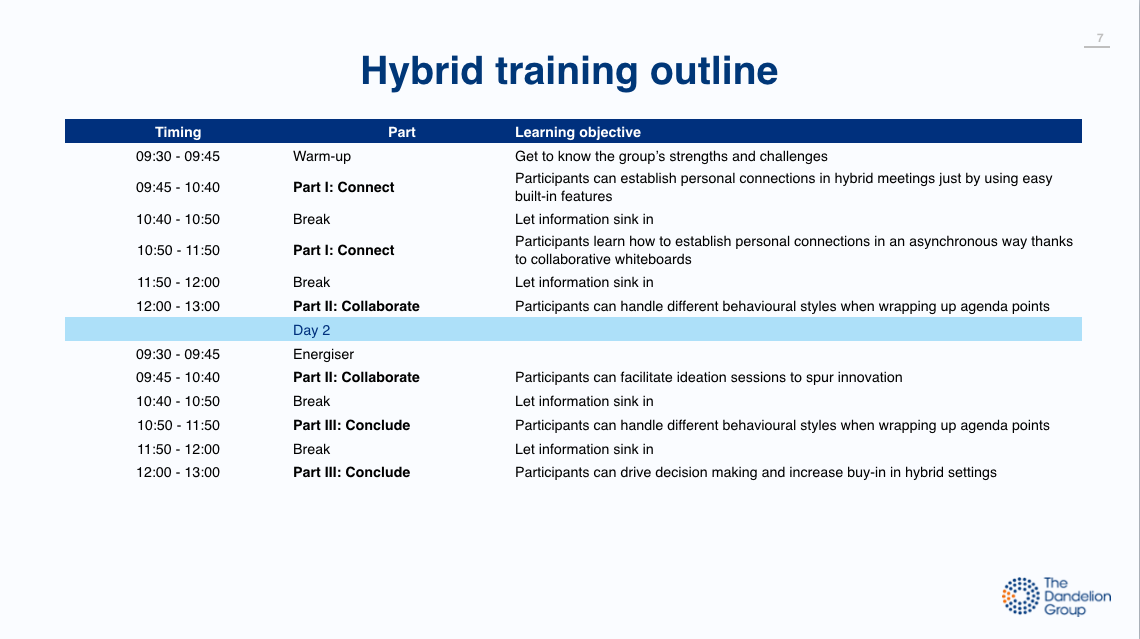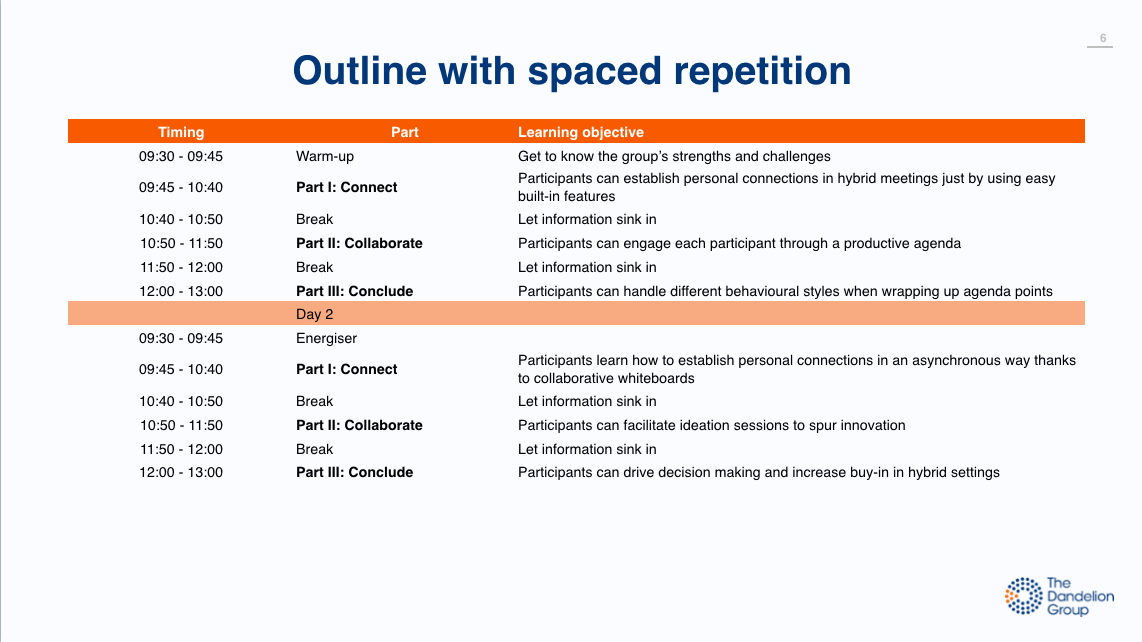What works in workshops?
Training your team sharpens skills and pushes productivity. How can we design workshops that work?
Alakazam!
Unfortunately, one can’t just wave a magic wand to create an effective course. When you google tips for workshops, plenty of websites pop up suggesting to start by defining the training’s learning outcomes with the participants. Although this is certainly a good way to get the ball rolling, you can easily end up with an avalanche of suggestions. Ticking all boxes is a Sisyphus job. We recommend whittling down feedback and spelling out the training’s purpose in one sentence as well as the three main skills that you want the participants to hone or acquire. Keep everything that does not contribute to the objective to a minimum or remove it completely.
Effective trainings cannot be a quiz show. Our main objective should not just be that participants recall facts or figures. This will not unlock their true potential. Speaker and training designer Cathy Moore also developed a checklist to spot information dumps and promote action-oriented materials. To trigger behavioural change, we have to look at the different learning levels - and aim high.
Over 60 years ago, in the same year that Christine Lagarde was born, cognitive psychologists from the University of Chicago created a helpful tool: Bloom’s taxonomy. It consists of six elements making it easier for us to assess whether a module aims at lower levels of learning or higher-order skills. The revised version (in the video below) shows the stages and differences. Basic trainings make students remember information or understand a concept. Intermediate trainings give students the chance to apply the acquired knowledge and analyse cases. Expert trainings sharpen participants’ skills in evaluating different options or creating completely new solutions on their own.
All systems go!
An outstanding trainer does not just present knowledge but facilitates learning. In her evidence-based guide for trainers, Ruth Colvin Clark explains which instructive methods work best in which setting. To drop a few examples, quizzes only work with groups that are not familiar with the topic. (Non-animated) Visuals on slides but also drawings or charts created by participants lead to better learning. Games can have a big impact when played multiple times, and scenarios work well when you need to motivate a cohort. Her most striking finding is, however, that the statement “learning by doing” is not always valid.
Interactions can flop. Colvin Clark mentions examples where “active engagement actually depressed learning”. It is crucial to consider the learners’ experience and the different learning styles. Newcomers, for example, require more structure whilst we can give an experienced cohort more freedom and resources. When we then design the sessions, they should consist of exercises for the four widely known styles - visual, auditory, reading and kinesthetic (VARK). If you are very ambitious, you can go through the extended list, also comprising logical, social and solitary. Even though each learner fits into more than one box, mixing up your sessions with VARK or another theory reduces the risk that participants feel left behind.
Spaced repetition is an underrated technique if your training lasts for a day or more. In his book “Course design strategy”, Ethan Honary advocates repeating sessions in smaller units than following the standard format. Imagine a training with three parts. Most trainings kick off with part one in the morning, followed by a coffee break and part two, and concluding with part three and a Q&A in the afternoon. You could, alternatively, also run parts 1,2 and 3 with short exercises in the morning, followed by a second round of exercises for parts 1, 2 and 3 in the afternoon. You can also organise shorter sessions on different days. Learners will (almost) forget information but, ultimately, learn more because they are retrieving it. Honary calls this “an effective refresh” that maximises memory storage.
There is no golden rule on how long a session should be, yet our learners appreciate a break every 60-90 min. This does not mean that we need to prepare long-winded monologues but should think about breaking up sessions into exercises that build on each other. Every eight minutes there should, ideally, be an opportunity to digest new information, The Bob Pike Group recommends. Check out their podcast if you are looking for creative training techniques.
Eureka!
Having a relevant goal and interactive outline would not be enough to get Archimedes to jump to his feet. The Greek inventor from Sicily reminds us of an element that is part of every impactful workshop. More than 2200 years ago, the ancient scientist discovered a missing piece in his research on the law of buoyancy while taking a bath. The deeper he sank, the more water left the tub, triggering an epiphany (and him jumping in joy nakedly). Even if you are not teaching physics, we should think of Archimedes and try to pave the way for such eureka moments.
Epiphanies require effort. They often happen when we get stuck and struggle, so do not worry if your participants look slightly puzzled when you explain a task. If everybody accomplishes the exercises with ease, we need to elevate our course. Three extremely effective ways to trigger eureka moments are introducing reflective activities, turning trainees into teachers and transforming content into a different format.
Symonds collected seven free reflection and revision exercises.You can use these to invite the group to answer questions when introducing a chapter but also to debrief after an exercise. It is also effective when you discuss alternative ideas, bust misconceptions or let them work on a task before learning techniques to do it better. Such teaching does not only boost engagement in the classroom but also develops critical thinking and, consequently, deepens understanding.
You can take it to the next level with peer teach-backs. There, a person explains a concept to the rest of the group. They can also moderate an exercise. Letting participants work in small groups enhances the learning experience but check if the chosen moderators need some time to prepare. As soon as the discussions kick off, we as trainers, observe and only intervene to answer questions or if somebody shares false information. If you are dealing with many groups, just invite each to give a quick summary. The goal is to let them learn from each other.
The last type of activities are those where participants transform what they have learned into a different format. This could be testing a concept in a role play, drawing it or using it to solve a challenge they face at work. In our workshops, we use our own techniques and tools in the exercises to make sure that participants apply the acquired knowledge in a new setting. If you have time, you can thus design tailored tasks.
Whichever path to eureka moments you choose, make sure that you incorporate productive engagement. The technical term for this is “deliberate practice”. It means giving participants tasks that are not just fun to do but relevant to their performance and challenging to complete. When you hear the phrase “Now I get it!”, you have successfully worked your magic and made not just Archimedes proud.
Three tips to improve your trainings
Avoid information dumps by honing three crucial skills.
Vary activities and give people time to reflect every ten minutes.
Lead learners to eureka moments with challenging exercises.
- written by Benjamin Wilhelm, benjamin[at]thedandeliongroup.eu
Learn the techniques. Boost your confidence. Make your point.
Click here to unlock your potential.



